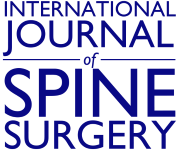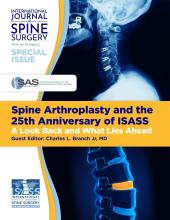ABSTRACT
Background This trial reports the 2-year and immediate postremoval clinical outcomes of a novel posterior apical short-segment (PASS) correction technique allowing for correction and stabilization of adolescent idiopathic scoliosis (AIS) with limited fusion.
Methods Twenty-one consecutive female AIS patients were treated at 4 institutions with this novel technique. Arthrodesis was limited to the short apical curve after correction with translational and derotational forces applied to upper and lower instrumented levels. Instrumentation spanned fused and unfused segments with motion and flexibility of unfused segments maintained. The long concave rods were removed at maturity. Radiographic data collected included preoperative and postoperative data for up to 2 years as well as after long rod removal.
Results All 21 patients are beyond 2 years postsurgery. Average age at surgery was 14.2 years (11–17 years). A mean of 10.5 ± 1 levels per patient were stabilized and 5.0 ± 0.5 levels (48%) were fused. Cobb angle improved from 56.1° ± 8.0° to 20.8° ± 7.8° (62.2% improvement) at 1 year and 20.9° ± 8.4°, (62.0% improvement) at 2 years postsurgery. In levels instrumented but not fused, motion was 26° ± 6° preoperatively compared to 10° ± 4° at 1 year postsurgery, demonstrating 38% maintenance of mobility in nonfused segments. There was no report of implant-related complications.
Conclusions PASS correction technique corrected the deformity profile in AIS patients with a lower implant density while sparing 52% of the instrumented levels from fusion through the 2-year follow-up.
Footnotes
Disclosures and COI: K-Spine Inc. funded this study from 2012-14 prior to being acquired by K2M in 2015. L. Rehák received grants/research support from DePuy Synthes Spine and Kspine. M. Repko received grants/research support from Kspine. M. Grevitt received grants/research support from DePuy Synthes Spine and Medtronic and acted as a consultant for DePuy Synthes Spine. U. Aydinli received grants/research support from Kspine. A. Carl served on an advisory board or panel for K2M and Kspine and acted as a consultant and received other financial or material support (royalties, patents, stock options, etc.) from Kspine. C. Nnadi has no conflicts. B.A. Akbarnia was a stock or shareholder for Alphatec and Nuvasive; received grants/research support from DePuy Synthes Spine and Nuvasive; was a consultant for Ellipse Technology, K2M, and Kspine; served on an advisory board or panel for Kspine; and received other financial or material support (royalties, patents, stock options, etc.) from Kspine, Nuvasive, K2M, Ellipse Technology, and Depuy Synthes Spine. D. Crandall was a consultant for Ellipse Technology, Kspine, Medtronic, Spinewave, Stryker, and Zyga; served on an advisory board or panel for Kspine and on a speaker's bureau for Stryker; and received other financial or material support (royalties, patents, stock options, etc.) from Kspine and Medtronic. For the rest of coauthors nothing was disclosed. This study was Institutional Review Board–approved at each participating institution prior to initiation. The medical device stated in this manuscript is not cleared by US Food and Drug Administration.
- ©International Society for the Advancement of Spine Surgery







